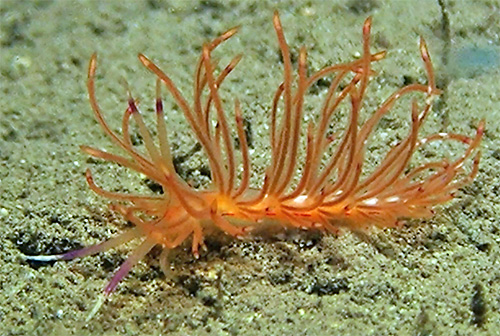| Home |
| Acknowledgments |
| Conventions |
| Glossary |
| Maps |
| References |
| Links |
| Articles |
| Thumbnails |
| Species
list |
| Family |
| Next
species |
Additional Photos

semi-side

top

front

more white

feeding?

mating

carrying eggs

eggs?

Unidentia sp. #1

| Maximum Size: about 20 mm. Identification: The body of this aeolid is translucent-cream with brown branches of the digestive gland. There are three longitudinal red-violet lines on the notum, one central and two lateral with the central one grading into a violet tip on the "tail". Posterior to the first two ceratal arcs, a series of irregular white patches fills the space between the red-violet lines on each side. The dorsal cerata are very long with subapical cream patches and irregular red-violet spots on their anterior faces as well as a few small, white spots on their sides. The rhinophores are long and smooth with subapical white patches and red-violet bands. The cephalic tentacles are long with white tips and violet medial bands. The oral tentacles are lightly frosted with white, dorsally. Some animals have more extensive white patches on their cerata and rhinophores. Natural History: Unidentia sp. #1 is known from at least eight animals found crawling, at night, at a depth of about 5 m (15 ft). They were at a protected site with a silty bottom and were found on an orange-pink hydroid (Corydendrium cf. parasiticum) in association with Tenellia sp. #16. It probably feeds on that hydroid and it may lay a light orange egg mass on it. Distribution: Big Island. Taxonomic notes: It was first recorded in Hawaii from Kawaihae, Big Island by Pam Madden on July 25, 2023. It's similar in form to Unidentia aliciae, from the western Pacific, but differs from it in some details of the color pattern (such as the presence of dorsal white patches). A subset of photographed Unidentia, from the western Pacific, that have such patches also appear to have somewhat shorter cerata. Photo: Pam Madden: about 20 mm; side: Kawaihae, Big Island; July 25, 2023. Observations and comments: Note 1: ( ) |
| Thumbnails |
Species
list |
Family | Next species | Top |